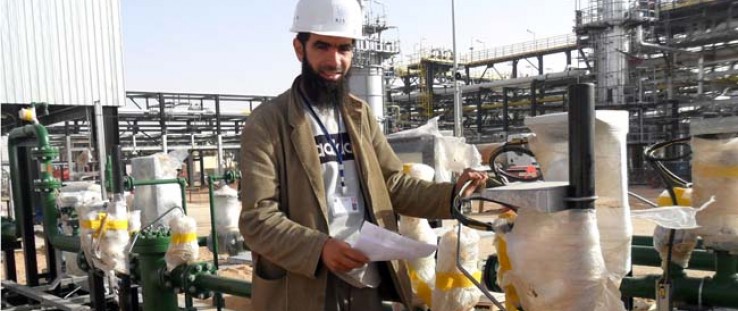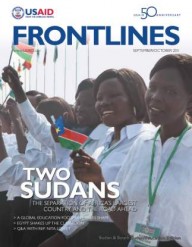 Bilel Boutadjine, an engineer and former University of Mentouri Constantine (UMC) student, is pictured at his job at KIS Co. Bilel credits the UMC Career Center for helping him find the job.
Maellem Dekhil
Bilel Boutadjine, an engineer and former University of Mentouri Constantine (UMC) student, is pictured at his job at KIS Co. Bilel credits the UMC Career Center for helping him find the job.
Maellem Dekhil
 Bilel Boutadjine, an engineer and former University of Mentouri Constantine (UMC) student, is pictured at his job at KIS Co. Bilel credits the UMC Career Center for helping him find the job.
Maellem Dekhil
Bilel Boutadjine, an engineer and former University of Mentouri Constantine (UMC) student, is pictured at his job at KIS Co. Bilel credits the UMC Career Center for helping him find the job.
Maellem Dekhil
Bilel Boutadjine had big dreams of working as an engineer in his native Algeria following graduation from the University of Mentouri, Constantine (UMC). But as his matriculation ended, Boutadjine knew his employment outlook was bleak.
Gainful employment doesn’t come easy in his home country, which has an unemployment rate of 10 percent, and where 23 percent of the population lives below the poverty line.
Boutadjine decided that enrolling in the new Career Center at his school would help him improve a number of basic skills, make him more marketable to potential employers, and eventually secure him a good job.
Created in 2009, the Career Center is the result of a USAID-supported university partnership between the William Davidson Institute at the University of Michigan and UMC. Also known as RESUME (Recruiting Employable Students at the University with Management Education), this partnership aims to make a difference in the lives of more than 4,000 Algerian college students who, like Boutadjine, have earned a bachelor’s degree and are in need of career counseling.
During his time at the center, Boutadjine strengthened his public speaking and networking skills; attended career fairs that put him in direct contact with potential employers; and gained access to resources that shaped his career plan. Armed with those skills—as well as a healthy dose of confidence, he found his dream job at an industrial construction company soon after graduation.
“I [now] work as an engineer [at] KIS company, one of the Career Center’s partners; an interesting and stimulating job which I would not have been able to find without the help of the center,” Boutadjine said.
His is not the partnership’s only success. In less than two years, that one center has helped more than 230 students secure internships, and nearly 60 students secure permanent full-time positions. Because of its success, the Algerian Ministry of Higher Education has announced plans to establish 18 more throughout Algeria based on the UMC model.
Higher Education for Development
The partnership is one of 69 managed by Higher Education for Development (HED), an organization that works closely with USAID and the six major U.S. presidential higher education associations (American Council on Education, American Association of Community Colleges, American Association of State Colleges and Universities, Association of American Universities, Association of Public and Land-grant Universities, and the National Association of Independent Colleges and Universities) to support U.S. university and other higher-education institutions’ involvement in international development.
The HED partnership program supports a key component of USAID’s education strategy, namely, improving the ability of host-country higher-education institutions and workforce-development programs to produce a skilled workforce that will facilitate their country’s development. Improved career counseling and mentoring are seen as important steps in achieving this goal.
Linking Universities Across the Border
Several other higher-education partnerships are working to advance entrepreneurism and small-business development, including two separate efforts between U.S. and Mexican universities: one between the University of Texas at San Antonio (UTSA) and Universidad Autónoma de Guadalajara (UAG), followed by another between UTSA and Universidad Veracruzana.
“These higher education partnerships with funding support from USAID are connecting small-business owners to the global marketplace—helping small- and micro-entrepreneurs create jobs, and improving the overall competitiveness of the Mexican economy,” says Robert McKinley, UTSA’s associate vice president for economic development.
Back in 2003, the UTSA/UAG partnership, supported under the U.S.-Mexico Training, Internships, Exchanges and Scholarships program, created more than 40 small business development centers (SBDCs) located throughout Mexico based on a successful U.S. model.
Subsequently, the UTSA/Veracruzana partnership expanded the initial effort by creating a network of Mexican SBDCs that engaged higher-education institutions throughout Mexico and leveraged federal government resources. As a result, more than 4,000 Mexican business owners received professional training, and more than 1,000 SBDC professionals from every Mexican state have graduated from its Counselor and Director Diplomado Training Program. The network now has 101 centers throughout Mexico.
Connecting Small Businesses
A key factor in its success has been an online, multi-lingual trade platform that assists small businesses from both Mexican and U.S. SBDC networks to connect and make deals. Launched in 2010, SBDCGlobal.com enables clients to find pre-qualified international suppliers and buyers to create sales and growth.
“Small businesses have had a difficult time benefiting from globalization,” said Cliff Paredes, director of the UTSA International Trade Center. “This will help tens of thousands of businesses by connecting them to one another and by providing online tools and information that they need to grow their businesses.”
Gabriela Esparza is the owner of one such business. Her printing and design company is benefitting from this online tool. Esparza says with the support of the university, she’s learning the importance of having a business plan and making smarter decisions about her investment strategy. “We are certain to succeed,” she added.
All told, since the start of the program, more than 750,000 U.S. SBDC clients have had the opportunity to connect with Mexican businesses to create bilateral trade opportunities.
“This mutually beneficial network will enhance our U.S. small business sector, creating jobs here at home by strengthening professional connections to neighboring countries and their communities in one of the highest and best uses of foreign assistance funding,” said Tully Cornick, HED’s executive director.
Several other Latin American countries have expressed interest in adopting the SBDC model in their countries. El Salvador, a country that was recently announced as a focus of a new economic growth partnership in Latin America, already has eight centers in operation, with a total of 14 slated to be in operation by year’s end. Three centers are planned for Colombia.
Development of an SBDC network in Central America, set to launch in late 2011, will be a key action item in the Pathways to Prosperity in the Americas Initiative as it will help create jobs and promote greater regional economic integration and stability. Pathways is a State Department-led, policy-level dialogue that allows countries to share ideas and initiatives for economic growth to more broadly benefit all citizens.
“An SBDC expansion of such size and scope would solidify the role of U.S. higher education and its host-country institution partners in providing the resources needed to empower thousands of individuals to become full participants in the global economy,” Cornick added.









Comment
Make a general inquiry or suggest an improvement.